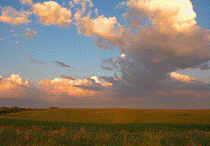North American Prairie Conference
Date of this Version
1989
Abstract
As part of research to develop a sustainable agriculture that incorporates many aspects of the North American Prairie, I) the seasonal phytomass levels supportable by native prairie and 2) how plant taxa shift in temporal importance within the community were examined. This report summarizes the first two years of a study documenting community patterns on three tallgrass prairie sites in Saline County, Kansas that differ in soil type and annual productivity. Average August phytomass at the three sites ranged from 284 to 682 g/m2 in 1986 and from 377 to 1077 g/m2 in 1987. Diversity declined with standing crop biomass and from spring to summer at all sites. Although big bluestem (Andropogon gerardii Vitman) dominated all sites, legumes represented as much as 26% of total phytomass on the poorest site. Some composite species were ubiquitous, but never constituted more than 5% of vegetation. Spring forbs and cool-season grasses were of greatest importance in April and May. The results, in concert with other ongoing research, have implications for the design of perennial seed crop mixtures suited for the Great Plains.


Comments
Published in Prairie Pioneers: Ecology, History and Culture: Proceedings of the Eleventh North American Prairie Conference, August 7-11, 1988, Lincoln, Nebraska (Lincoln, NE 1989).